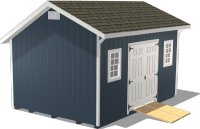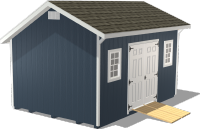Greenhouse Foundations 101: Where to Build for Success
by Dakota Storage Buildings, on June 12, 2024
.jpg?width=900&height=450&name=Blog_Greenhouse%20Foundation_900x450%20(2).jpg)
When you want to add backyard greenhouses to your garden, it is natural to be swept away by the visual aspects — picking out the ideal location directly in the sun and imagining rows upon rows of your favorite plants. However, the foundation is a crucial aspect that is often overlooked. It ensures the long-term durability, stability, and functional success of your greenhouse. A well-thought-out foundation anchors your greenhouse securely to the earth, safeguards it against strong winds, and plays a critical role in water management, insulation, and pest control. Investing time in understanding the diverse materials, construction techniques, and site preparation requirements lays down the groundwork for a sustainable, productive, and durable space.
The Critical Role of Greenhouse Foundations
Grasping the fundamentals of a solid foundation is essential for every successful backyard greenhouse. A well-constructed foundation acts as the backbone for the entire structure's integrity and functionality. It ensures your greenhouse remains resilient, come rain or shine. A solid foundation maintains the greenhouse's stability in harsh weather, preventing any unsettling shifts or movements that could compromise its structure. It carries the weight of the greenhouse distributing this load evenly to avoid any undue stress on the construction materials. A strong greenhouse foundation is your first line of defense against the warping or cracking that temperature fluctuations and ground movement can cause, ensuring that your plants remain in a secure and stable environment free from harm.
Benefits of a Strong Foundation for Stability and Strength
There are numerous advantages of dedicating time and resources to building a strong foundation for your greenhouse.
|
|
Prolong Lifespan: It significantly prolongs the lifespan of the structure, safeguarding your investment and ensuring that it continues to serve its purpose year after year. |

|
Better Insulation: A solid foundation contributes to better insulation properties of the greenhouse, maintaining a more consistent internal temperature and facilitating optimal plant growth conditions. |

|
Deters Pests: A well-constructed foundation acts as a deterrent to various pests and critters that might otherwise invade your greenhouse. By creating a secure barrier, it helps maintain a controlled and safe environment for your plants to flourish. |
Risks of Neglecting Foundation
Overlooking the foundation when planning your backyard greenhouse ideas can have major repercussions. Without a stable base, your greenhouse is vulnerable to water entry, leading to potential flooding or the accumulation of moisture that can encourage mold growth and rot. These conditions are damaging to the structure and its plants. Structural instability is another significant risk, as an uneven or weak foundation can lead to misalignment of the greenhouse's components. This impairs its functionality and can potentially make door and window operation problematic. In extreme scenarios, an unreliable foundation could result in the greenhouse's partial or total collapse under adverse weather conditions. These catastrophic outcomes highlight the critical role of the foundation in ensuring the safety, longevity, and success of your greenhouse project.
The First Steps for New Greenhouse Projects
Establishing resilient and long-lasting backyard greenhouses begins with careful planning and preparation. You must consider several key factors that will influence the greenhouse's functionality and productivity.
Sunlight Exposure: Positioning your greenhouse so it will receive an abundance of sunlight exposure is essential. A site that captures optimal daylight is crucial for plant growth and energy efficiency.
Easily Accessible: Easy access for construction, maintenance, and water and electrical supply, are practical considerations that can greatly impact the day-to-day operations of the greenhouse.
Proper Site Preparation: This can include leveling the ground and removing any debris or vegetation that might interfere with the foundation. This is crucial in preventing future issues and ensuring a solid base for construction.
Assessing Soil Conditions and Drainage Concerns
It is also important to thoroughly assess the soil conditions and drainage capabilities of your greenhouse placement. Different soil types, from sandy to clay, have varying impacts on moisture retention and the foundation’s stability. Identifying your soil type can inform necessary adjustments or improvements to ensure it can adequately support your greenhouse. Proper drainage is essential to safeguard the foundation from water damage. Inadequate drainage can lead to water pooling around the base of the structure, a scenario that not only threatens the foundation's integrity but can also create a breeding ground for pests and diseases detrimental to plant health.
Determining the Appropriate Size and Shape of the Foundation
The final preparatory step in laying a solid foundation for your greenhouse involves determining the precise size and shape of the foundation itself. This decision is directly influenced by the greenhouse's intended size and design. A correctly sized foundation ensures that the structure is adequately supported, preventing uneven settling or distortion that could compromise the greenhouse's integrity. The foundation's shape plays a role in maximizing the use of available space while accommodating any site-specific constraints or requirements. Ensuring that the dimensions are accurately planned and executed provides a stable and level base, setting the stage for a greenhouse that will stand firm against the elements and time.
Best Materials to Build a Strong Greenhouse Foundation
Choosing the right materials for your greenhouse foundation is a pivotal step toward ensuring its longevity, stability, and functionality. The foundation material not only supports the structural integrity of the greenhouse but also influences factors such as drainage, insulation, and even pest resistance. Selecting a material that aligns with your greenhouse's specific needs, environmental conditions, and budget is crucial for maximizing the effectiveness and durability of your foundation.
Concrete Foundations

Concrete is one of the most popular choices for greenhouse foundations due to its durability and strength. Its strong nature ensures that the greenhouse structure is securely anchored, capable of withstanding harsh weather conditions, including strong winds and heavy rains. Concrete foundations also offer the benefit of deterring pests and rodents from burrowing beneath the greenhouse, providing an additional layer of protection for your plants. However, concrete foundations typically require a higher financial investment, not only for the materials themselves but also for the labor. Despite the initial investment, the long-lasting reliability of concrete can provide peace of mind, knowing that your greenhouse rests on a solid, permanent base.
Gravel Foundations

Gravel foundation is a more cost-effective and DIY-friendly option. Gravel has excellent drainage properties, preventing water from pooling around the greenhouse and ensuring that excess moisture is effectively directed away from the foundation. This characteristic is particularly beneficial in areas prone to heavy rainfall, as it helps to mitigate the risk of water damage and foundation erosion over time. Gravel foundations can be more forgiving than concrete in terms of installation, allowing for adjustments and modifications without the need for specialized equipment or extensive construction experience. However, it is important to acknowledge that while gravel provides good drainage and is more budget-friendly, it might not offer the same level of stability and longevity as concrete.
The Value of Partnering With Your Provider for Foundation Needs
Having a conversation with your greenhouse provider before initiating any construction work is a crucial step that can significantly streamline your project. This discussion can unlock valuable insights, prevent costly mistakes, and ensure that your backyard greenhouse ideas are set up for success from the very beginning. Your provider possesses a wealth of knowledge about the specific requirements and best practices for setting up their greenhouses for backyard gardens. This conversation can reveal opportunities for optimizing your foundation in ways you might not have considered, such as integrating systems for improved water drainage or insulation. Discussing your greenhouse foundation ideas with your provider also allows you to clarify any questions or concerns you may have, ensuring that every decision you make is informed and deliberate.
Determining Foundation Requirements
The foundation requirements for greenhouses for backyard gardens can vary widely depending on several factors, including the structure's size, design, intended use, and even the geographical location. Recognizing that there is no one-size-fits-all solution is essential in planning your backyard greenhouse ideas. Your provider plays a crucial role in this phase, offering tailored advice based on years of experience and specific knowledge about the models they supply. They can guide you on whether a simple gravel foundation suffices for your needs or if a more substantial concrete base is required to ensure the longevity and stability of your greenhouse. This expert guidance is valuable in customizing your foundation to match the unique characteristics of your greenhouse. Engaging with your provider at this stage ensures that your greenhouse foundation is not only functional but also compliant with any relevant building codes or regulations, thereby safeguarding your investment.
Customizing Foundation Plans
Personalization is a key aspect of creating a foundation that not only supports your greenhouse effectively but also aligns with your gardening aspirations and aesthetic preferences. Working closely with your greenhouse provider gives you the opportunity to design a foundation plan that precisely fits your greenhouse. This allows you to address any greenhouse foundation ideas you may have, whether it is incorporating features for enhanced drainage to support hydroponic systems or ensuring the foundation materials complement your garden's landscape design. Customizing your foundation plan with the help of your provider ensures that every detail is accounted for. This level of customization not only enhances the functionality and appearance of your greenhouse but also makes the gardening experience more enjoyable and fulfilling.
Laying a Solid Foundation for Your Greenhouse

Creating a solid foundation for your greenhouse may initially sound overwhelming. However, with high-quality materials, and expert advice, this essential phase of greenhouse setup becomes more manageable. Each decision and action you take in building your foundation is a step towards securing your backyard greenhouse ideas against the challenges posed by time, weather, and natural wear and tear, ensuring it remains a reliable haven for your plants. The effort you invest in constructing a robust foundation today lays the groundwork for the thriving garden of tomorrow.
If you are ready to get started, browse our selection of stock backyard greenhouses and consider which model aligns with your gardening goals and space requirements. With Dakota Storage Buildings, you will find that establishing the perfect foundation for your greenhouse is well within your reach, paving the way for a gardening space that will be used for many seasons to come. Take this crucial first step with confidence, knowing that a well-built foundation is the backbone of any successful greenhouse.


























